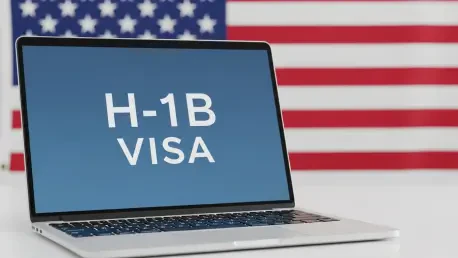Introduction
Imagine a world where the brightest minds in technology and science face a staggering $100,000 barrier just to work in the United States, a country long regarded as a beacon for global talent. This is the reality following a recent policy change that has dramatically increased the application fee for H-1B visas, a program vital for bringing skilled foreign workers into American industries. The decision has sent shockwaves through the tech sector and beyond, raising questions about the future of innovation in the U.S. and the global movement of expertise.
This FAQ article aims to address the most pressing questions surrounding this significant fee hike. It explores the policy’s implications for industries, workers, and international competition for talent. Readers can expect clear answers on how this change affects various stakeholders and which countries might benefit from the shift in skilled labor dynamics.
The scope of this content covers the specifics of the policy, its impact on key sectors, and the potential opportunities for other nations. By delving into these aspects, the article seeks to provide a comprehensive understanding of a decision that could reshape the landscape of global employment in critical fields like STEM (science, technology, engineering, and mathematics).
Key Questions or Key Topics
What Is the H-1B Visa Fee Hike and Why Was It Implemented?
The H-1B visa program allows U.S. companies to hire foreign workers with specialized skills, particularly in technology and related fields. A recent decree has raised the application fee for each new H-1B petition to $100,000, a sharp increase from the previous range of $2,000 to $5,000. This fee also applies to extensions, though it does not affect existing visa holders or applications submitted before the policy’s effective date.
The primary reason behind this drastic change is to prioritize American workers by making it cost-prohibitive for companies to hire foreign talent. Critics of the H-1B program have long argued that it enables firms to employ overseas professionals at lower wages, potentially displacing domestic employees. The policy reflects a protectionist stance aimed at safeguarding local jobs amid ongoing debates about immigration and economic fairness.
This shift also includes a focus on high-skilled, high-paid applicants in the visa lottery system, indicating an intent to limit access to only elite talent. While the annual cap remains at 65,000 visas for general workers, with an additional 20,000 for advanced-degree holders, the financial barrier could significantly alter how companies approach staffing needs in specialized sectors.
How Does the Fee Hike Affect the Technology Industry?
The technology sector stands as the most impacted by this policy, with roughly two-thirds of H-1B visa holders employed in tech roles. Major corporations such as Amazon, Google, and Microsoft, which have historically relied on this program to fill critical positions, now face substantial cost increases to maintain their global workforces. The financial burden could hinder their ability to innovate at the same pace.
Beyond corporate challenges, the policy creates uncertainty for current visa holders and prospective applicants. Some companies have advised their H-1B employees to avoid international travel due to potential re-entry issues, highlighting the immediate operational disruptions. The tech industry’s reaction has been one of concern, as losing access to international talent could slow down projects and affect competitiveness on a global scale.
Leaders in the field, many of whom benefited from the H-1B program themselves, have voiced worries about long-term effects. The risk of diminished innovation and growth in a sector that drives much of the U.S. economy underscores the stakes involved. This situation could push firms to explore alternative locations for talent acquisition, reshaping industry dynamics.
Which Nationalities Are Most Affected by This Change?
Indian nationals, who accounted for 71% of approved H-1B visas in recent data, bear the brunt of this fee increase, followed by Chinese nationals at 11.7%. For many of these workers, the program has been a pathway to career opportunities and family stability in the U.S. The new financial barrier threatens to disrupt these aspirations, creating personal and professional challenges.
Concerns have been raised about the humanitarian impact, including potential family separations and economic hardship for those unable to afford the fee. Governments of affected countries have noted the strain this places on their citizens, with calls for dialogue on mitigating the fallout. The policy’s focus on cost could disproportionately exclude talent from emerging economies, altering demographic trends in visa approvals.
This disparity raises questions about equity in access to opportunities within the U.S. labor market. As a significant portion of skilled workers from specific regions face exclusion, the cultural diversity that has enriched American industries might also diminish, affecting workplace environments and global perspectives in key sectors.
Which Countries Stand to Gain from the U.S. Policy Shift?
As the U.S. imposes stricter barriers, several nations are positioning themselves to attract skilled workers deterred by the exorbitant H-1B fees. The United Kingdom, for instance, is exploring initiatives to waive visa fees for highly skilled professionals, aiming to bolster its economy through a dedicated task force focused on global talent in science and technology.
China has introduced a new visa category to welcome STEM professionals, allowing them to study and work without pre-arranged employment. South Korea, meanwhile, is actively seeking to capitalize on the situation by targeting scientists and engineers, aligning with national priorities in artificial intelligence and tech-driven growth for the coming years.
Canada has adjusted its immigration policies to lower entry thresholds for skilled workers seeking permanent residency, alongside past programs that facilitated transitions for H-1B holders. These global efforts indicate a competitive race for talent, with each country recognizing the economic boost that comes from integrating skilled professionals into their labor markets.
What Are the Broader Economic Implications for the U.S.?
The fee hike risks triggering a “brain drain” from the U.S., as talented individuals seek opportunities in more welcoming environments. This exodus could undermine the nation’s position as a leader in innovation, particularly in technology, where foreign workers have historically filled critical skill gaps and driven advancements.
Economic growth may also suffer if companies struggle to access the expertise needed for cutting-edge projects. The policy’s protectionist intent, while aimed at supporting American workers, overlooks the complementary role foreign talent plays in creating jobs and fostering entrepreneurship, as seen in the contributions of numerous industry pioneers.
Critics argue that the long-term cost of losing global competitiveness could outweigh short-term gains in domestic employment. The balance between safeguarding local jobs and maintaining an innovative edge remains a complex challenge, with potential ripple effects across various sectors reliant on international collaboration and expertise.
Summary or Recap
This article addresses critical facets of the H-1B visa fee hike, shedding light on its purpose to prioritize American workers through a $100,000 application cost. The technology industry emerges as the primary sector affected, grappling with increased expenses and potential innovation setbacks. Indian and Chinese nationals, who dominate H-1B approvals, face significant personal and professional hurdles due to this financial barrier.
Globally, countries like the United Kingdom, China, South Korea, and Canada are seizing the opportunity to attract displaced talent with favorable immigration policies. The broader economic implications for the U.S. include risks of a talent exodus and diminished competitiveness, highlighting the tension between protectionism and the need for global expertise. These insights underscore the multifaceted impact of the policy on various stakeholders.
For those seeking a deeper understanding, exploring resources on international labor mobility or immigration policy reforms in competing nations can provide additional context. Reports from industry associations and government statements on talent attraction strategies also offer valuable perspectives on how this shift continues to unfold on a worldwide stage.
Conclusion or Final Thoughts
Reflecting on the discussions held, it becomes evident that the H-1B visa fee hike marks a pivotal moment in shaping global talent distribution. The decision stirs debates on balancing national interests with the undeniable benefits of international expertise, leaving industries and workers to navigate a transformed landscape.
Moving forward, stakeholders are encouraged to monitor how competing nations refine their policies to welcome skilled professionals, potentially setting new benchmarks for immigration frameworks. Exploring alternative strategies, such as partnerships with countries offering talent-friendly environments, emerges as a viable step for companies affected by the change.
Ultimately, the situation prompts a broader consideration of how immigration policies can adapt to sustain innovation while addressing domestic priorities. Individuals and organizations alike find value in assessing their roles within this evolving dynamic, weighing options to advocate for balanced reforms or seek opportunities in emerging global hubs.









